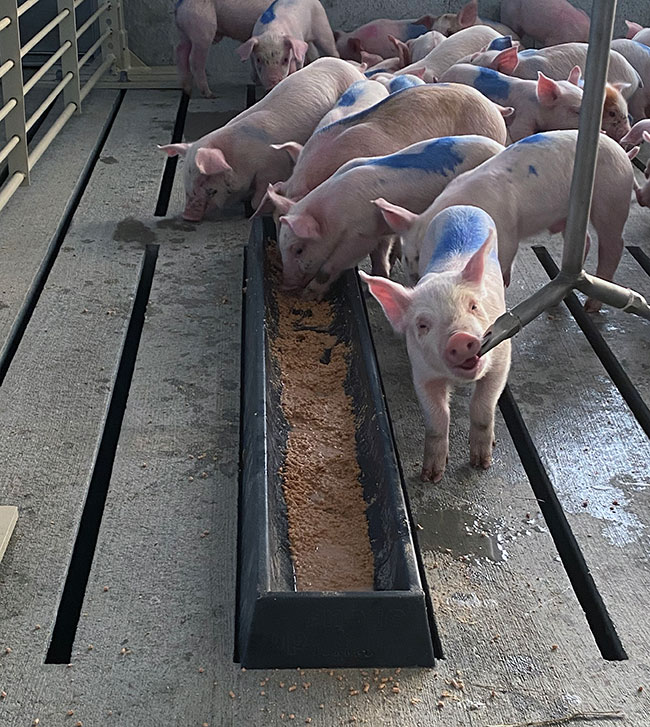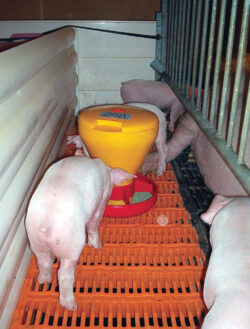
Features
Innovation
The most crucial week
By Jeff Tribe
Maintaining nutrient uptake for weaning pigs
 “If you expose these pigs to stressors, you do have problems... that’s a lifelong effect.”
Photo courtesy of Dr. Madie R. Wensley.
“If you expose these pigs to stressors, you do have problems... that’s a lifelong effect.”
Photo courtesy of Dr. Madie R. Wensley. Imagine if you will, a small child, lunchbox in hand heading nervously off to their first day of school.
And now, think of a weaning piglet, also leaving the warm, familiar embrace of its mother and littermates for a strange new environment, unfamiliar food and a dynamic hierarchal group setting populated by aggressive strangers.
“There’s a lot of similarities to kindergarten,” says Dr. Mike Tokach, Professor/Swine Extension Specialist at Kansas State University.
Both are embarking on intimidating and life-changing journeys. While the child will return home at school’s end, the piglet has begun a crucial and challenging transition whose short-term success or failure can dictate profitability or loss to a farm’s bottom line.
Feed intake during the seven to 14-day post-weaning timeframe is vital to pigs’ long-term health and viability, says Tokach, most particularly perhaps through the first three days.
“That early period after weaning has caused a lot of difficulty.”
Major stressors on piglets at weaning include maternal separation, littermate and established hierarchy separation, establishing a new hierarchy in a larger group of strange piglets, adapting to a larger communal space, feed neophobia (reluctance to adapt to strange new food) and arriving at an appropriate feed-to-water ratio.
“Those are all things they have to adjust to,” says Tokach.
There are multiple strategies to help piglets acclimatize, addressing feed and potential stressors including environment and socialization.
“Anything we can do to lower that stress is important,” says Dr. Madie R. Wensley, who as a graduate student headed a 2021 Kansas State University review of pre-weaning strategies to maintain nutrient intake.
Successful weaning relies on getting piglets to that crucial point in good shape, arguably beginning with sow health and nutrition, pre-natal development and post-natal milk production. Deficiencies in feed, vitamins or trace minerals can hamper milk and colostrum quantity and quality.
“And reduce the ability of the sow to pass immunity to her piglets,” adds Tokach.
Colostrum intake’s importance during the hours following birth cannot be overstated he continued, particularly for smaller pigs. Larger piglets generally do well enough, but techniques such as split suckling ensuring smaller pigs get a minimum of two hours of colostrum access in the first 24, ‘or ideally 12 hours’ can reduce morbidity from 30 per cent to between eight and 10 per cent.
“That’s a big difference,” said Tokach.
Creep feeding is accepted practice for introducing and helping piglets adjust to solid feed. High quality is a must says Tokach, noting pigs aren’t as attracted to lower quality feed.
“You don’t get enough of the pigs to become eaters.”
Ease of access and ample supply are important, while attractants including ‘play feeders’, tying ropes or pieces of cloth to feeders which pigs come to chew on, have proven successful.
“And they find the feed is there and start chewing on the pellets.”
Research is underway on ‘open housing’ common creep areas allowing shared feed access to multiple litters, as at Mark Schwartz’s large Minnesota operation. This practice offers potential to combine feed intake with socialization, “while they are still nursing the sows.”
Under the ‘kindergarten’ analogy, this could equate to ‘pre-school’ or ‘play dates,’ ultimately lowering aggression and fighting resulting in enhanced post-weaning growth.
It may also put smaller, less competitive pigs at a disadvantage.
“They have to compete with more pigs now,” says Tokach, seeking additional research. “How do we apply this concept of open housing for the piglets in a way we don’t disadvantage the smaller pigs?”
Feed cubes thrown onto the floor, combining toy and nutritional source, are another option.
“Pigs like toys [and] destructible things, and will pick them up and run with them.”
Supplementing both pre- and post-weaning with milk or milk replacer is another approach Tokach sees gaining traction in Europe with increased litter sizes. Research indicates benefits at weaning, particularly for lighter pigs, but not ‘multiplier’ effects later in life, meaning ‘it has to pay for itself at weaning.’
Cost/benefit calculations result, along with required procedure and sanitation against disease.
“You have to be dedicated to it to go that route,” says Tokach.
“It’s going to be an approach we’re going to have to learn more about to apply correctly.”
Work under professor Charlie Maxwell and others at the University of Arkansas has identified positive results through exposing piglets to topsoil, says Tokach. It’s not practical to run piglets outdoors or shovel dirt into their pens, but related feed or inoculant-based probiotic enhancement is a possibility.
“There are some components in the soil pigs really respond to,” Tokach said, alluding to microbial and bacterial advantages in the gastro-intestinal tract.
“Very, very exciting and a lot of potential.”
Weaning timing is a critical choice. To reduce bacteria-based disease, earlier weaning ages were encouraged, at one point between 18 and 21 days.
“Now, we’ve learned if you do expose these pigs to stressors, you do have problems,” says Tokach, including ongoing immunity and gastro-intestinal issues. “That’s a lifelong effect.”
Tokach says producers with very healthy barns and no exposure to disease or stress can wean very young and do well. However, in conjunction with concern around increased susceptibility to ongoing gastro-intestinal issues among pigs weaned younger, improved procedures around controlling bacteria-based diseases which lowers their comparative impact to viral-based problems, suggested weaning age has risen to between 24 and 26 days. At that point, gut response benefits appear to plateau.

An example of creep feeding pigs, pre-weaning.
Photo courtesy of
Dr. Madie R. Wensley.
“They will respond to stress much, much better than pigs weaned between 18 and 21 days.”
Ready access to fresh, clean water is crucial, including details like blowing bowls out with a leaf-blower following disinfecting from the previous group.
“You don’t want their first drink of water to be of disinfectant,” adds Tokach.
Adding low-level nutrients or vitamins to water is also possible.
“But you don’t want to overdo it,” he stressed, noting pigs which can’t find feed may fill up on water instead. “You don’t want to have too much in the water to discourage them from going to the feed.”
Mat feeding, placing small amounts of feed onto floor mats up to four times daily in the first seven to ten days post-weaning is another feed consumption encouragement strategy, says Wensley.
Beyond crucial feed and water availability, air temperature and quality are also vitally important, moving enough air so there isn’t an ammonia problem inside a pig-friendly climate which isn’t too hot or too cold.
“Have all the things with the environment in place so you aren’t adding additional stress to the stressors already in place,” explains Tokach.
Pigs are social creatures he says, preferring to touch at rest. Being too far apart may be an indication of heat stress, lying on top of each other, cold stress.
“Meet the temperature needs of the pig.”
Increased monitoring to identify pigs who are struggling in the first days of weaning is of the utmost importance. Issues may be hard to identify immediately, says Tokach, but emerge between 36 and 48 hours.
“You really want to look at finding pigs who haven’t started on feed.”
“Catch fall-behinds early so they can get additional care,” concurs Wensley. “That is an important one.”
Well beyond every anticipatory or preventative measure, boots on the ground and eyes on the pigs during weaning’s earliest stages may be the most important factor.
“The more times we observe those pigs and walk through the pens the first two weeks after weaning, the more beneficial it is to get those pigs started,” says Wensley.
She recommends monitoring weaning pigs four times a day. “Two being the very minimum.”
Targetted mat or gruel (mixed feed and water) feeding is advised for fall-behinds, easily accessible in either situation.
“So they don’t have to fight to find it,” says Tokach.
In conclusion, there are many dietary, environmental and stress-related factors involved in helping pigs maximize nutrient intake after weaning. However, the most important of all may be the farmer.
“What it boils down to is really good management in the first two weeks,” Wensley summed up.
“The success and failure in a group of pigs almost always lies in the hands of the person taking care of them in the barn,” Tokach concluded. “Nutritionists, veterinarians, geneticists, we all have our role. But the person in the barn is the most important.”
Print this page